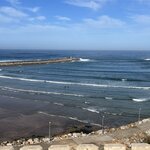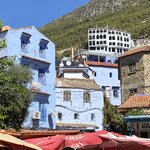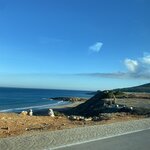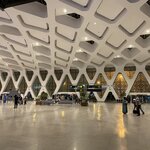Highlights
- Wander the blue-washed streets of Chefchaouen
- See ruins of the Roman Empire's farthest African reach at Volubilis
- Discover the tanneries and artisan workshops in Fes
- Watch henna artists and acrobats in Marrakesh's Jemaa el-Fna Square
Brief Itinerary
| Day | Highlights | Overnight |
|---|---|---|
| Day 1 | Arrive in Tangier, Transfer to Chefchaouen | Chefchaouen |
| Day 2 | Transfer to Fes via Volubilis & Meknes | Fes |
| Day 3 | Explore the Medieval Medina of Fes | Fes |
| Day 4 | Transfer to Casablanca via Rabat | Casablanca |
| Day 5 | Transfer to Marrakesh, Explore | Marrakesh |
| Day 6 | Depart Marrakesh |
Detailed Itinerary
Day 1: Arrive in Tangier, Transfer to Chefchaouen

Welcome to Tangier—the gateway between Europe and Africa. Located close to the south of Spain, visit the medina (old quarter) and take a paseo to enjoy a stroll along the promenade. Or, travel straight on to the blue-hued city of Chefchaouen in the Rif Mountains. Enjoy the scenic route, stopping along the way to hike (two to three hours) to the Cascades d'Akchour (Waterfalls of Akchour). Chefchaouen offers endless winding, narrow streets, and picturesque buildings. Find Plaza Uta el-Hammam for a restaurant or café and enjoy a meal as you people-watch.
Though non-Muslims are not permitted to enter, the Grand Mosque is still worth a visit. From there, explore the nearby kasbah (old fortification) and tour the garden, museum, and some of the old prison cells. Follow a path outside of the city walls to Hotel Atlas and climb to the rooftop to enjoy a panoramic view of the Blue City. For the slightly more athletic, follow the street east to pass over the Ras el Ma Spring and ascend the path (20-30 minutes) until you reach the abandoned white Spanish Mosque. Enjoy one last view over Chefchaouen as the sun sets behind the mountains.
Day 2: Transfer to Fes via Volubilis & Meknes

Rise early to snap photos of the people-less streets before leaving for Fes. Stop along the way at the UNESCO-protected Volubilis ruins—the Roman's farthest reach in Africa. Wander the complex, exploring merchant homes with still-intact heating systems, temples, and many mosaics in situ. Continue on to the smaller, less busy version of Fes, Meknes, for an introduction to your first historic imperial city. The two main points of interest are the Ville Impériale (imperial city) and the medina. Be sure to visit the Bab al-Mansour gate, the Mausoleum of Moulay Ismail, and the Royal Stables.
Continue east to your second imperial city, Fes. With its impressively large (and somewhat confusing) old medina, Fes is a city worth getting lost in. Before venturing into the medina, drive up the hill to take the time to visit the Merenid Tombs located just north of the city and enjoy the all-encompassing view of historic Fes and the surrounding area. Descend the hill and find your way to your riad (a traditional Moroccan house with an interior garden), where you can enjoy a delicious meal and relax for the evening.
Chat with a local specialist who can help organize your trip.
Day 3: Explore the Medieval Medina of Fes

Fes is the oldest of the imperial cities in Morocco (Marrakesh and Rabat are the other two) and perhaps the most interesting to explore. A UNESCO-protected site, the city hasn't undergone much colonial development, leaving you to experience its medieval charm. Fes consists of two old medina quarters, Fes el Bali (where you'll spend most of your time) and Fes el Jdid (a slightly newer part of the city), and the early 20th-century French-designed Ville Nouvelle. Meet your guide to help you navigate the narrow and maze-like ancient streets of the medinas, starting in Fes el Bali (789 CE).
Note the Spanish and Tunisian-influenced architecture as you pass the variety of souks (markets) offering spices, leather goods, and pewter. Known for its tanneries and the acrid smell associated with them, visit the popular Chouara Tannery and climb to the roof of a nearby shop for a better view of the goings-on. Visit the 14th-century Al Attarine Madrasa and admire the zellij tile work before checking out one of the oldest, still operating universities in the world, Al-Qarawiyyin University (859 CE). Find the Mellah (old Jewish quarter) in Fes el Jdid for another encompassing view of the city.
Day 4: Transfer to Casablanca via Rabat

Leave Fes behind and venture north to the imperial city (and present-day capital) of Rabat. Explore the medieval fortification of the Chellah Necropolis and wander the Roman and Islamic ruins. Enter through the grand door of the Kasbah des Oudaias into Rabat's old city center. From there, visit the 20th-century Andalusian Gardens and enjoy the serene space away from the crowds. Discover the Hassan Tower, a minaret of the incomplete mosque and Mausoleum of Mohamed V, a 12th-century project that was abandoned, leaving only the minaret and some 200 columns.
Continue south to Casablanca and transfer to your hotel. Take a stroll along the Boulevard de la Corniche, the beach promenade that follows the Atlantic (often referred to as Morocco's 'Miami') to the Hassan II Mosque. Though tours of the interior are only offered in the morning, take advantage of the timing and watch the sunset behind the architectural marvel. Grab a bite in Rick's Café, a restaurant, bar, and café recreated to reflect the bar in the movie classic Casablanca.
Day 5: Transfer to Marrakesh, Explore

Casablanca is a modern, commercial capital of Morocco and is home to the Hassan II Mosque. It sits on an outcrop over the Atlantic and has a 690-foot (210 m) minaret—the tallest structure in Morocco and the tallest minaret in the world! It's estimated the courtyard can hold 80,000 worshipers, with room for 25,000 inside. What makes this mosque unique is that it's one of the few mosques in the country where non-Muslims can enter. Join a morning tour and admire the exquisitely ornate artisanship: hand-carved stone and wood, intricate marble floor detailing, and gilded cedar ceilings.
Upon arriving in Marrakesh, settle into your accommodation and take the rest of the afternoon at a slower pace. In the early evening, the main square, Jemaa el-Fna, comes alive with musicians, performers, snake charmers, games, and food stalls. Wander the square at your leisure and have a bite and a glass of fresh mint tea in one of the many cafés that sit above the square and enjoy the spectacle below.
Day 6: Depart Marrakesh

Marrakesh nicknamed the "Red City" (for its 1000-year-old red sandstone city walls and buildings), is a major economic center and home to a thriving medina. Begin west of Jemaa el-Fna and walk toward the striking minaret of the Koutoubia Mosque and Gardens. The 253-foot (77 m) high minaret is the tallest tower built in Marrakesh. Explore the stalls in Souk el-Attarin (Spices), Souk Haddadine (blacksmiths), and Souk Smata (slippers) before visiting the Ben Youssef Madrasa (Islamic school) for a taste of 16th-century architecture and marvel at the details.
As you walk Marrakesh's alleys, notice the fondouks—medieval inns along ancient trade routes that provided travelers and merchants with shelter and supplies. Today, some have been converted into residences, while others are shopping areas and workshops that you can explore. Depending on your energy level, you may wish to visit a few sites south of Jemaa el-Fna. Some options to consider are the 500-year-old Saadian Tombs, the extensive courtyard and sunken gardens of the 17th-century El Badi Palace, or the intricate woodwork and painted ceilings of the 19th-century Bahia Palace. Or, if you prefer a quiet respite from the afternoon heat to end your trip, you may wish to check out Majorelle Gardens and relax amid sub-tropical plants, bamboo, lilies, and palms.
More Great Morocco Itineraries
Looking for more inspiration for your trip to Morocco? Check out these other Morocco itineraries, explore different ways to spend six days in Morocco, or discover the best time to visit Morocco.








